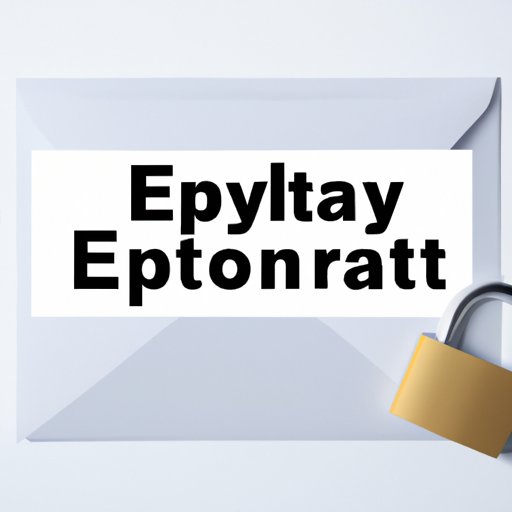
Introduction
Email is an integral part of modern communications, but unencrypted email is not secure. If you use Outlook for work or personal email, encrypting your emails can protect your privacy from hackers and spying eyes. This guide provides a comprehensive overview of how to encrypt Outlook email, including why it’s important, how to do it, and the best encryption tools on the market.
Why Encrypting Outlook Email is Important
The primary reason to encrypt your Outlook email is to protect your privacy and sensitive information. Without encryption, your email is vulnerable to potential data breaches, identity theft, or corporate espionage. In short, anyone who wants to access your email can do so if they intercept your unencrypted messages. This is particularly important if you work in a high-security industry or regularly send sensitive information as part of your daily communications.
Encryption ensures that your emails are encrypted in transit and at rest, keeping your communication private and secure. This makes it much more difficult for hackers and cybercriminals to access your emails, decreasing the likelihood of them gaining access to your personal or work-related data.
How to Encrypt Outlook Email
The process of encrypting Outlook email is relatively straightforward, but it’s essential to follow the steps carefully to ensure that your email is securely encrypted. The following steps show you how to encrypt your emails in Outlook 365:
- Open up Outlook 365
- Go to the “File” menu and select “Options”
- Click on “Trust Center” from the options on the left-hand side
- Click on “Trust Center Settings”
- Select “Email Security”
- Check the “Encrypt contents and attachments for outgoing messages” box
- Optionally, you can also check the “Add digital signature to outgoing messages” box
- Click “OK” to save the settings
Once you’ve completed these steps, any outgoing messages you send will automatically be encrypted.
Common Mistakes to Avoid
Make sure you have a digital certificate set up before trying to encrypt your emails in Outlook. Outlook uses your digital certificate to provide the security you need. Without it, you won’t be able to encrypt your emails.
It’s also essential to double-check that your recipient can decrypt your emails. If your recipient’s email client doesn’t support encryption or decryption, your message won’t be secure. Always check with your recipient to confirm their decryption capabilities before sending any sensitive information.
Encryption Tools for Outlook Email
Several encryption tools are available to users who want to secure their Outlook email. Here are three of the top tools on the market:
1. Virtru
Virtru is a cloud-based encryption tool that works with several email clients, including Outlook. With Virtru, you can encrypt your emails at the message level, so you don’t need to encrypt every email you send. Virtru offers robust encryption features, such as message revocation and forwarding prevention.
The main disadvantage of Virtru is that all parties involved in an email conversation must use the Virtru client to encrypt and decrypt messages.
2. ProtonMail
ProtonMail is an excellent encryption tool that provides end-to-end encryption of emails. This means that only the sender and recipient can read the message, making it incredibly secure. ProtonMail also offers features such as anonymous email addresses to ensure that your communications remain private.
The main disadvantage of ProtonMail is that it requires both parties to use ProtonMail as their email provider to use the encryption features fully.
3. GPG Suite
GPG Suite is a free and open-source encryption tool that uses the OpenPGP standard for encryption. GPG Suite has been around for over a decade and provides robust encryption capabilities. It integrates well with several email clients, including Outlook.
The main disadvantage of GPG Suite is that it requires a bit more technical expertise to set up and use correctly compared to other encryption tools.
Advanced Encryption Techniques for Outlook Email
For users who want to take extra precautions, there are several more advanced encryption techniques to explore. One option is to use an encryption key, which can provide an additional layer of protection for sensitive emails. You can also enable two-factor authentication for your email account, making it more challenging for hackers to access your email even if they do get past your encryption.
It’s always a good idea to stay up-to-date on the latest encryption techniques and tools to ensure your email communications remain secure.
Outlook Email Encryption FAQs
Outlook Email Encryption 101
If you’re new to email encryption, it can be intimidating. However, it doesn’t have to be. Encryption works by scrambling the text of your message so that only the intended recipient can read it. Outlook uses a digital certificate to provide encryption, and you can choose to encrypt messages at the folder or message level.
Beginner’s Guide to Encrypting Outlook Email
For the ultimate beginner’s guide to encrypting Outlook email, follow these simple steps:
- Log in to your Outlook account.
- Click “File” in the top left-hand corner of the screen and select “Options.”
- Click on “Trust Center” from the options on the left-hand side and then select “Trust Center Settings.”
- Click on “Email Security,” then check the “Encrypt contents and attachments for outgoing messages” box.
- Optionally, you can also check the “Add digital signature to outgoing messages” box.
- Click “OK” to save the settings.
Following these steps will ensure that your email communications are encrypted in Outlook. Additionally, it’s always a good idea to use a strong password and two-factor authentication to keep your email account secure.
Conclusion
Encrypting your Outlook email is the single most effective way to protect your privacy from malicious actors. Whether you’re using Outlook for work or personal communication, it’s important to take steps to secure your data. This guide has provided a comprehensive overview of why email encryption is essential, how to encrypt your Outlook email, and the top encryption tools on the market. By following these tips, you can rest assured that your communication will remain secure.




